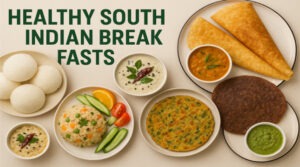Your day begins with what you eat — and in South India, breakfast is sacred. But which options truly nourish your body and support lasting energy? Let’s dive into a scientifically backed guide to the healthiest South Indian morning meals.

Why South Indian breakfasts have an edge
South Indian breakfasts often use fermented batters, lentils, millets, and vegetables — ingredients that improve digestibility, add fiber, and supply micronutrients. The fermentation process boosts beneficial gut bacteria, enhancing nutrient absorption and glycemic control. Some breakfast items like vada-sambar show lower glycemic index (GI) values in analyses of typical South Indian breakfast foods.
Moreover, many of these meals are relatively low in added fat and use minimal oil, making them lighter choices for starting the day.
Top healthiest South Indian breakfast items & how to maximize their benefits
Here are some of the best picks, along with tips to make them even healthier.
1. Idli + Sambar / Chutney
- Why it’s good: Steamed idlis are low in fat, easy to digest, and made with fermented rice + urad dal. Fermentation enhances B-vitamin production and may assist blood sugar regulation.
- How to boost it: Use mixed grains or millets (e.g. ragi, foxtail millet) in the batter; add vegetables or legumes to sambar; keep chutney oils minimal.
2. Pesarattu (Green Gram Dosa / Crepe)
- Why it’s good: Made from green gram (moong or whole mung beans), it’s rich in protein, fiber, and lower glycemic load.
- How to boost it: Mix in finely chopped onions, ginger, and greens. Serve with mint or tomato chutney and limit oil during cooking.
3. Adai / Mixed Lentil Pancake
- Why it’s good: Uses a blend of lentils and rice/millet, giving more protein and fiber than pure rice batters. Many diet guides highlight adai as a protein-rich, low GI option.
- How to boost it: Add grated vegetables, flax or chia seeds, and reduce rice proportion in the batter.
4. Upma (Semolina or Millet Upma with Vegetables)
- Why it’s good: When made with coarse semolina or whole-grain millet, and loaded with vegetables, upma gives fiber, micronutrients, and slow-release carbs.
- How to boost it: Prefer broken millet upma (e.g. broken ragi, broken foxtail) or oat + vegetable upma. Use less fat, and temper with mustard seeds, curry leaves, ginger.
5. Ragi / Finger Millet Dishes (Ragi Dosa / Ragi Rava Idli / Ragi Upma)
- Why it’s good: Ragi (finger millet) is high in calcium, fiber, and good quality resistant starch. Its GI is lower than refined rice. Many healthy breakfast lists feature ragi dosa and ragi idli as superior options.
- How to boost it: Use a millet + lentil blend to improve texture and protein; pair with protein-rich chutneys or dal.
6. Quinoa / Oat Dosa / Oat Upma versions
- Why it’s good: These newer hybrids reduce reliance on pure rice, increase fiber, and lower glycemic load. High-protein South Indian breakfast guides include quinoa upma and oat dosa.
- How to boost it: Soak grains well, mix with a little lentil, and add vegetables or herbs for flavor and nutrients.
What to watch out for & tips to optimize
- Balance protein & fiber: Pure rice or semolina breakfasts tend to spike sugar. Lentils, mung, and veggies help buffer that.
- Limit oil & fried foods: Avoid or reduce deep-fried items like medu vada, or choose baked / air-fried versions.
- Portion control: Even healthy breakfasts can overshoot energy needs if eaten in large quantities.
- Add healthy sides: Coconut chutney (lightly made), sambar rich in vegetables, plain yogurt or buttermilk can add probiotics and micronutrients.
- Rotate grains & pulses: Don’t eat rice every day. Alternate ragi, foxtail millet, bajra, etc.
- Pre-soaking / fermentation: Soak ingredients well, allow for fermentation — these reduce anti-nutrients (phytates), improve digestibility, and lower GI.
- Include greens / herbs / spices: Curry leaves, ginger, methi seeds, fennel, coriander — useful for antioxidants, flavor, and metabolism boost.
Leave a Reply